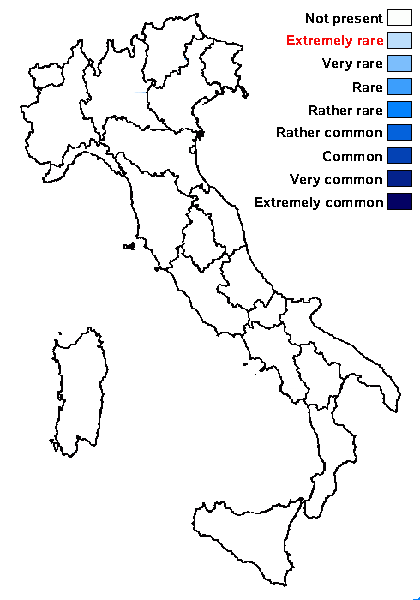Miriquidica nephaea (Sommerf.) P.F. Cannon
in Cannon & al., Revisions of British and Irish Lichens, 25: 77, 2022. Basionym: Lecanora nephaea Sommerf. - Suppl. Fl. Lapp.: 103, 1826.
Synonyms: Lecanora atrocincta Th. Fr.; Protoparmelia nephaea (Sommerf.) R. Sant.
Distribution:
Description: Thallus crustose, episubstratic, chestnut brown to copper-brown, usually somewhat shiny, verrucose-areolate, 0.3-0.4 mm thick, indistinctly and shortly lobed at margins, forming large patches, with a dark powdery prothallus consisting of dark greenish blue, 4-5 µm thick, thick-walled hyphae. Soredia dirty white to brown, arising in 0.2-0.3 mm wide soralia. Thalloconidia often present on the prothallus and along the lower sides at the margins of areoles, sooty-black to dark blue, mostly (2-)4-6-celled to submuriform, coarsely warted, 10-12(-14) x 6-10 µm, I+ blue, N+ purple. Cortex brown, with dark brown crystals soluble in K, 10-17 µm thick, often with a 7-15 µm thick epinecral layer; medulla whitish grey, of loosely interwoven hyphae 3-4 µm thick, I+ dark blue. Apothecia rare, lecanorine, sessile, (0.3-)0.5-0.8 mm across, with a red- to brown-black disc and a thin, entire thalline margin. Thalline exciple phenocorticate, c. 30 µm wide, with an outer gelatinous layer; epithecium olive-brown to dark yellow-brown, 6-9 µm high; hymenium colourless, (40-)50-90 µm high; paraphyses coherent, c. 1.7 µm thick at mid-level, the uppermost cells 2.5-3.5 µm wide; hypothecium colourless or pale yellow, 60-120 µm high. Asci 8-spored, clavate, approaching the Lecanora-type, but with a well-developed, weakly amyloid tholus and a relatively narrow, non-amyloid axial mass. Ascospores 1-celled, hyaline, ellipsoid to oblong-ellipsoid, 7-10(-12) x 3-3.5(-4.5) µm. Pycnidia black, immersed in low warts. Conidia straight or curved, 12-14(-20) x 0.8-1 µm. Photobiont chlorococcoid. Spot tests: cortex K-, C-, KC-, P-; medulla K+ yellow to yellow-brown or orange, C-, KC- or KC+ reddish violet, P+ yellow or orange, UV-. Chemistry: medulla with stictic and constictic acids or lobaric acid. Note: an arctic-alpine to boreal-montane species found on vertical to overhanging rock faces of metal-rich siliceous rocks; known form a few localities in Austria, but probably overlooked elsewhere; to be looked for in the Italian Alps.
Growth form: Crustose
Substrata: rocks
Photobiont: green algae other than Trentepohlia
Reproductive strategy: mainly asexual, by soredia, or soredia-like structures (e.g. blastidia)

Predictive model
Growth form: Crustose
Substrata: rocks
Photobiont: green algae other than Trentepohlia
Reproductive strategy: mainly asexual, by soredia, or soredia-like structures (e.g. blastidia)

Predictive model
 Index Fungorum
Index Fungorum
 GBIF
GBIF



